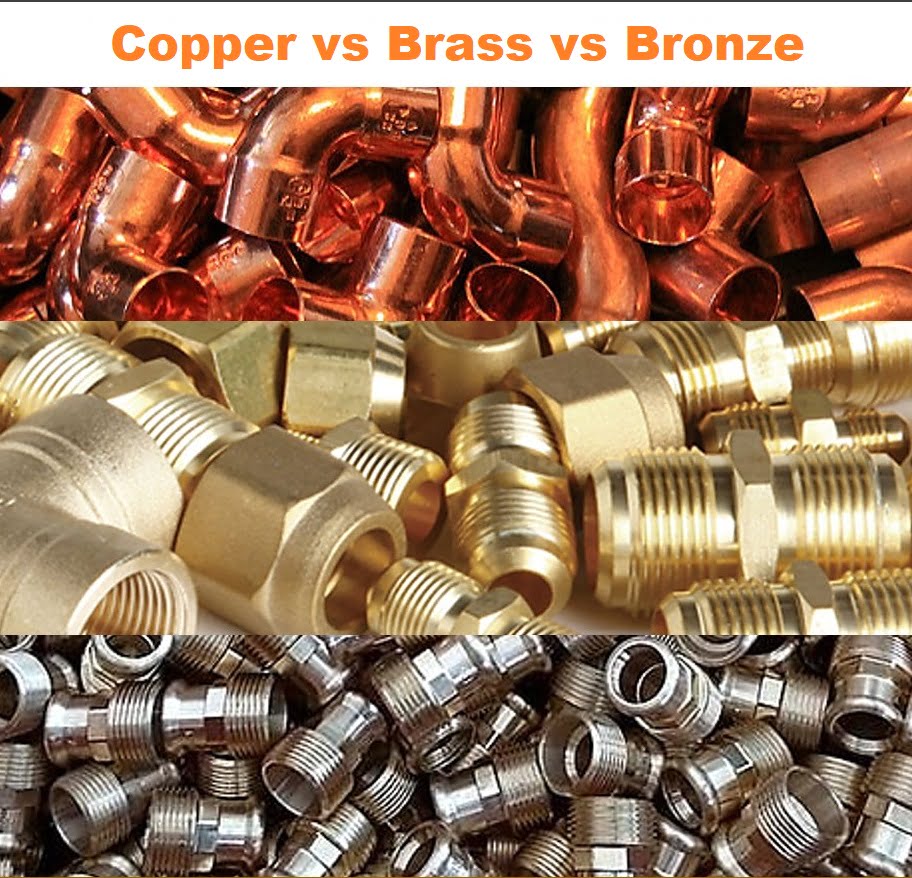ทองแดงกับทองเหลืองกับบรอนซ์: การเปรียบเทียบที่ครอบคลุม

ทองแดงทองเหลืองและบรอนซ์เป็นโลหะที่สำคัญที่สุดและใช้กันอย่างแพร่หลายในการใช้งานต่าง ๆ ตั้งแต่การก่อสร้างไปจนถึงอุปกรณ์อิเล็กทรอนิกส์ โลหะผสมแต่ละชนิดเหล่านี้มีคุณสมบัติและลักษณะเฉพาะที่ทำให้เหมาะสำหรับการใช้งานที่เฉพาะเจาะจง การทำความเข้าใจความแตกต่างระหว่างโลหะเหล่านี้สามารถช่วยในการเลือกวัสดุที่เหมาะสมสำหรับโครงการของคุณ บทความนี้สำรวจองค์ประกอบคุณสมบัติข้อดีและการประยุกต์ใช้ทั่วไปของทองแดงทองเหลืองและบรอนซ์
1. องค์ประกอบ
ทองแดง
- สัญลักษณ์เคมี: CU
- องค์ประกอบ: ทองแดงเป็นโลหะบริสุทธิ์ที่มีหมายเลขอะตอม 29
- โลหะผสมทั่วไป: ทองแดงมักถูกผสมกับองค์ประกอบเช่นสังกะสีดีบุกหรือนิกเกิลเพื่อสร้างโลหะผสมทองแดงที่แตกต่างกัน
ทองเหลือง
- สัญลักษณ์เคมี: cuzn
- องค์ประกอบ: ทองเหลืองส่วนใหญ่เป็นโลหะผสมของทองแดง (โดยทั่วไปคือ 55-95%) และสังกะสี (5-45%)
- โลหะผสมทั่วไป: องค์ประกอบอื่น ๆ เช่นตะกั่ว, ดีบุกหรืออลูมิเนียมอาจถูกเพิ่มเพื่อเพิ่มคุณสมบัติเฉพาะเช่นความสามารถในการกลึงหรือการต้านทานการกัดกร่อน
สีบรอนซ์
- สัญลักษณ์เคมี: cusn
- องค์ประกอบ: บรอนซ์ส่วนใหญ่เป็นโลหะผสมของทองแดงและดีบุก (ทองแดงประมาณ 60-90% และดีบุก 10-40%)
- โลหะผสมทั่วไป: องค์ประกอบอื่น ๆ รวมถึงอลูมิเนียมแมงกานีสหรือฟอสฟอรัสสามารถรวมไว้เพื่อปรับปรุงลักษณะเฉพาะ
2. คุณสมบัติ
ทองแดง
- สี: สีน้ำตาลแดง
- การนำไฟฟ้า: การนำไฟฟ้าและความร้อนที่ยอดเยี่ยม
- ความต้านทานการกัดกร่อน: ความต้านทานต่อการกัดกร่อนที่ดีโดยเฉพาะในสภาพแวดล้อมทางทะเล
- ความเหนียว: เหนียวและอ่อนมากช่วยให้สามารถสร้างรูปร่างและการขึ้นรูปได้อย่างกว้างขวาง
- ความแข็งแกร่ง: แข็งแกร่ง แต่ไม่แข็งแรงเท่ากับโลหะผสม
ทองเหลือง
- สี: รูปลักษณ์สีเหลืองทอง
- การนำไฟฟ้า: การนำไฟฟ้าที่ดีแม้ว่าจะไม่สูงเท่าทองแดงบริสุทธิ์
- ความต้านทานการกัดกร่อน: ความต้านทานปานกลางต่อการกัดกร่อน; สามารถพัฒนาคราบ
- ความเหนียว: นำเสนอความเหนียวที่ดี แต่แตกต่างกันไปขึ้นอยู่กับเนื้อหาสังกะสี
- ความแข็งแกร่ง: โดยทั่วไปแข็งแกร่งกว่าทองแดงบริสุทธิ์โดยเฉพาะอย่างยิ่งในโลหะผสมสังกะสีสูง
สีบรอนซ์
- สี: ลักษณะสีน้ำตาลแดงหรือสีทอง
- การนำไฟฟ้า: การนำไฟฟ้าที่ดี แต่ต่ำกว่าทองแดงและทองเหลือง
- ความต้านทานการกัดกร่อน: ความต้านทานการกัดกร่อนที่ยอดเยี่ยมโดยเฉพาะในน้ำทะเล ไม่ได้เสื่อมเสียอย่างง่ายดายเหมือนทองเหลือง
- ความเหนียว: ความเหนียวอย่างยุติธรรมแม้ว่าจะไม่มากเท่ากับทองแดง
- ความแข็งแกร่ง: โดยทั่วไปจะแข็งแรงและหนักกว่าทองแดงและทองเหลืองโดยเฉพาะอย่างยิ่งในโลหะผสมสูง
3. ข้อดี
ข้อดีของทองแดง
- การนำไฟฟ้า: เหมาะสำหรับการใช้งานไฟฟ้าเนื่องจากการนำไฟฟ้าสูง
- ความต้านทานการกัดกร่อน: มีประสิทธิภาพในสภาพแวดล้อมที่การกัดกร่อนเป็นเรื่องที่น่ากังวล
- ความอ่อนตัว: รูปร่างได้ง่ายในรูปแบบต่าง ๆ ทำให้มันหลากหลายสำหรับการผลิต
- การรีไซเคิล: รีไซเคิลได้สูงโดยไม่สูญเสียคุณสมบัติ
ข้อดีของทองเหลือง
- ความสามารถในการแปรรูป: ง่ายต่อการใช้เครื่องจักรมากกว่าทองแดงเนื่องจากธรรมชาติที่นุ่มนวล
- อุทธรณ์สุนทรียภาพ: รูปลักษณ์ที่น่าสนใจมักใช้ในการตกแต่ง
- คุณสมบัติต่อต้านแบคทีเรีย: ความต้านทานตามธรรมชาติต่อแบคทีเรียทำให้เหมาะสำหรับการประปาและอุปกรณ์
- ความอเนกประสงค์: มีให้เลือกหลายเกรดและสามารถปรับแต่งสำหรับแอปพลิเคชันเฉพาะ
ข้อดีของบรอนซ์
- ความทนทาน: ความแข็งแรงและความต้านทานที่ยอดเยี่ยมในการสวมใส่ทำให้เหมาะสำหรับการใช้งานหนัก
- ความต้านทานการกัดกร่อน: ประสิทธิภาพที่โดดเด่นในสภาพแวดล้อมทางทะเลเหมาะสำหรับการต่อเรือและการใช้งานชายฝั่ง
- แรงเสียดทานต่ำ: คุณสมบัติแรงเสียดทานที่ต่ำกว่าทำให้เหมาะสำหรับแบริ่งและบูช
- ไม่เกิดประกายไฟ: ปลอดภัยสำหรับใช้ในสภาพแวดล้อมที่ระเบิดได้
4. แอปพลิเคชันทั่วไป
แอปพลิเคชันของทองแดง
- สายไฟ: ใช้กันอย่างแพร่หลายในระบบไฟฟ้าเนื่องจากการนำไฟฟ้าที่ยอดเยี่ยม
- ประปา: ใช้กันทั่วไปสำหรับท่อและอุปกรณ์เนื่องจากความต้านทานการกัดกร่อน
- อิเล็กทรอนิกส์: ใช้ในแผงวงจรและตัวเชื่อมต่อ
- หลังคา: ใช้ในการใช้งานสถาปัตยกรรมเพื่อดึงดูดความงามและความทนทาน
แอปพลิเคชันของทองเหลือง
- เครื่องดนตรี: ใช้กันทั่วไปสำหรับเครื่องมือทองเหลืองเนื่องจากคุณสมบัติอะคูสติก
- อุปกรณ์และวาล์ว: ใช้ในการประยุกต์ใช้งานประปาและให้ความร้อน
- ของตกแต่ง: ใช้บ่อยในฮาร์ดแวร์และเครื่องประดับตกแต่ง
- ส่วนประกอบยานยนต์: ใช้ในเกียร์อุปกรณ์และบูชเนื่องจากความแข็งแรงและความทนทาน
แอปพลิเคชันของบรอนซ์
- ฮาร์ดแวร์ทางทะเล: ใช้ในอุปกรณ์เรือและใบพัดเนื่องจากความต้านทานการกัดกร่อนที่ยอดเยี่ยม
- ประติมากรรมและรูปปั้น: ใช้กันทั่วไปในงานศิลปะเนื่องจากความสวยงามและความทนทาน
- แบริ่งและบูช: ใช้ในเครื่องจักรสำหรับคุณสมบัติแรงเสียดทานต่ำ
- เหรียญประวัติศาสตร์: ใช้ในเหรียญกษาปณ์เนื่องจากความทนทานและความต้านทานการกัดกร่อน
5. สรุปความแตกต่าง
| คุณสมบัติ | ทองแดง | ทองเหลือง | สีบรอนซ์ |
|---|---|---|---|
| องค์ประกอบ | ทองแดงบริสุทธิ์ | ทองแดงและสังกะสี | ทองแดงและดีบุก |
| รูปร่าง | สีน้ำตาลแดง | สีเหลืองทอง | สีน้ำตาลแดง/ทอง |
| การนำไฟฟ้า | ยอดเยี่ยม | ดี | ดี |
| ความต้านทานการกัดกร่อน | ดี | ปานกลาง | ยอดเยี่ยม |
| ความเหนียว | เหนียวมาก | ดี | ยุติธรรม |
| ความแข็งแกร่ง | แข็งแกร่ง | แข็งแรงขึ้นโดยทั่วไป | แข็งแรงขึ้น |
| ความสามารถในการแปรรูป | ปานกลาง | สูง | ปานกลาง |
| การใช้งานทั่วไป | ไฟฟ้าประปา | ดนตรี, อุปกรณ์ | ทะเลแบริ่ง |
6. บทสรุป
ทองแดงทองเหลืองและบรอนซ์เป็นวัสดุสำคัญที่มีคุณสมบัติที่แตกต่างกันซึ่งรองรับการใช้งานที่หลากหลาย ทองแดงเก่งในการนำไฟฟ้าและความต้านทานการกัดกร่อนทำให้เหมาะสำหรับการใช้งานไฟฟ้าและประปา ทองเหลืองที่มีความสามารถในการใช้งานและความสวยงามมักใช้ในเครื่องดนตรีตกแต่งและดนตรี Bronze นำเสนอความทนทานและความต้านทานการกัดกร่อนที่ยอดเยี่ยมโดยเฉพาะในสภาพแวดล้อมทางทะเล
การเลือกวัสดุที่เหมาะสมขึ้นอยู่กับข้อกำหนดเฉพาะของแอปพลิเคชันรวมถึงความแข็งแรงความต้านทานการกัดกร่อนลักษณะที่ปรากฏและความสามารถในการกลึง การทำความเข้าใจลักษณะเฉพาะของทองแดงทองเหลืองและทองแดงช่วยให้สามารถตัดสินใจอย่างมีข้อมูลด้านวิศวกรรมการก่อสร้างและความพยายามทางศิลปะ โลหะแต่ละชนิดมีจุดแข็งของตัวเองทำให้พวกเขาขาดไม่ได้ในโลกสมัยใหม่
